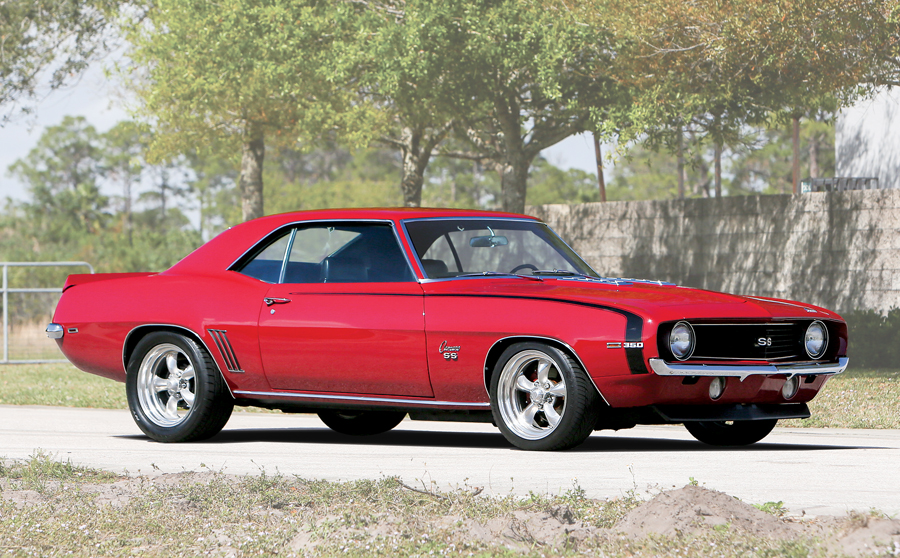- 300-hp, 350-ci V8 engine
- Automatic transmission
- Power steering and brakes
- Upgraded aluminum radiator
- Bucket seats with console
- Aftermarket stereo system
- American Racing wheels
SCM Analysis
Detailing
| Vehicle: | 1969 Chevrolet Camaro Custom |
| Years Produced: | 1967–69 |
| Number Produced: | 190,971 (1969 V8 coupe) |
| Original List Price: | $2,727 (base) |
| SCM Valuation: | $47,000 |
| Tune Up Cost: | $50 and a case of beer |
| Chassis Number Location: | Top of dash, driver’s side |
| Engine Number Location: | Block stamping at pad on front passenger’s side |
| Alternatives: | 1969 Pontiac Firebird, 1968 Ford Mustang fastback, 1970 Dodge Challenger |
| Investment Grade: | C |
This car, Lot 1115, sold for $34,100, including buyer’s premium, at RM Auctions’ Fort Lauderdale, FL, sale on March 29 and 30, 2019.
General Motors sold a ton of 1967–69 first-generation Camaros. Total production for all body styles and trim was 840,000-plus machines. That’s a lot of Camaros. Some were special ZL1s, COPOs, Z28s and the like. Most were not.
Our subject car is one of those common machines. There’s nothing special about it. It won’t ring any bells at an auction near you, nor will it get auction-house marketing staff all hot and sweaty. Still, this was a smart buy.
While there are plenty of guys who want to own an important car like a COPO or ZL1 — which is great for the hobby — there are multiples of wrench-turning, hard-working gearheads who just want a cool car they can drive and enjoy. This car, chassis whatever-the-number-is, represents that.
Street ready
Our subject car doesn’t claim to be a genuine SS, nor a matching-numbers example. What it does represent is that achievable icon that a bunch of buyers — both young and old — want in their garages.
This car looks great and would be easy to work on. If you need a part — any part — just jump on the Web and head to Camaro Central’s website, or even go to the local auto parts store. There’s a lot of value in that — different value than what you’d get out of owning a numbers-matching COPO or SS396.
You could modify it. Upgrade it. Customize it. Tune it for street or strip. Pile on the horsepower or add some creature comforts such as air conditioning for not a lot of dough. Burn tires for fun.
Use it for what it was intended to be — a tire-smoking, high-winding, get-’er-sideways type of machine. Enjoy it without all the worry that can accompany a “special” car that rarely gets driven and is treated like your grandmother’s creepy Hummel collection.
As such, a car like this, in all its non-special, go-have-fun-with-it glory, is a better representation of what a Camaro was originally supposed to be than any high-dollar collectible example on the market today.
Checking all the boxes
Our subject car doesn’t appear to be perfect — pretty far from it, actually. It’s not over-restored and still retains the look of an authentic Super Sport — even if it never left the factory that way. By the VIN, all we know about the car is that it was born with a V8 engine.
By way of on-board equipment, the auction-house description is pretty basic, which is as expected. All we really know is that we have a mild-mannered 300-horse 350 V8, automatic transmission along with power steering, power brakes, an MSD ignition and thermal-wrapped headers. Going off what we can see, it appears to be a nicely done street build with smart upgrades aimed at usability.
This car speaks to a huge audience and demographic. It offers a seasoned casual collector or first-time buyer the opportunity to own a car that is easy to own, not just from the wallet side of the equation, but also from the logical side. It’s like the Big Mac of desirable muscle cars: affordable, instantly recognized and pretty satisfying.
Running the numbers
In 2018, 287 1969 Camaros sold at auction. Most were like this car.
Per the ACC Pocket Price Guide, an ordinary V8 1969 Camaro coupe chimes in at a healthy $47,000 median value. This number is likely skewed since there are piles of cars in the database with minty-fresh restorations and another group of better-than-new resto-mods that can fetch north of $100k. But interest remains strong, and I think it will continue to be into the future.
The price paid here was right in line with other cars in similar condition and with a similar no-numbers configuration. Was it a deal? Absolutely.
The value is there because a ’69 is such a popular car, with a pile of buyers of all ages jonesing for it. This one was in a universally appreciated color combination, too. Assuming no deterioration to its look, you could easily sell this car again in short order, no matter how large or small your local market is, and get your money back.
That makes it an on-the-money deal for its new owner — and it was well bought as a driver that’s meant to be driven.
(Introductory description courtesy of RM Auctions.)
